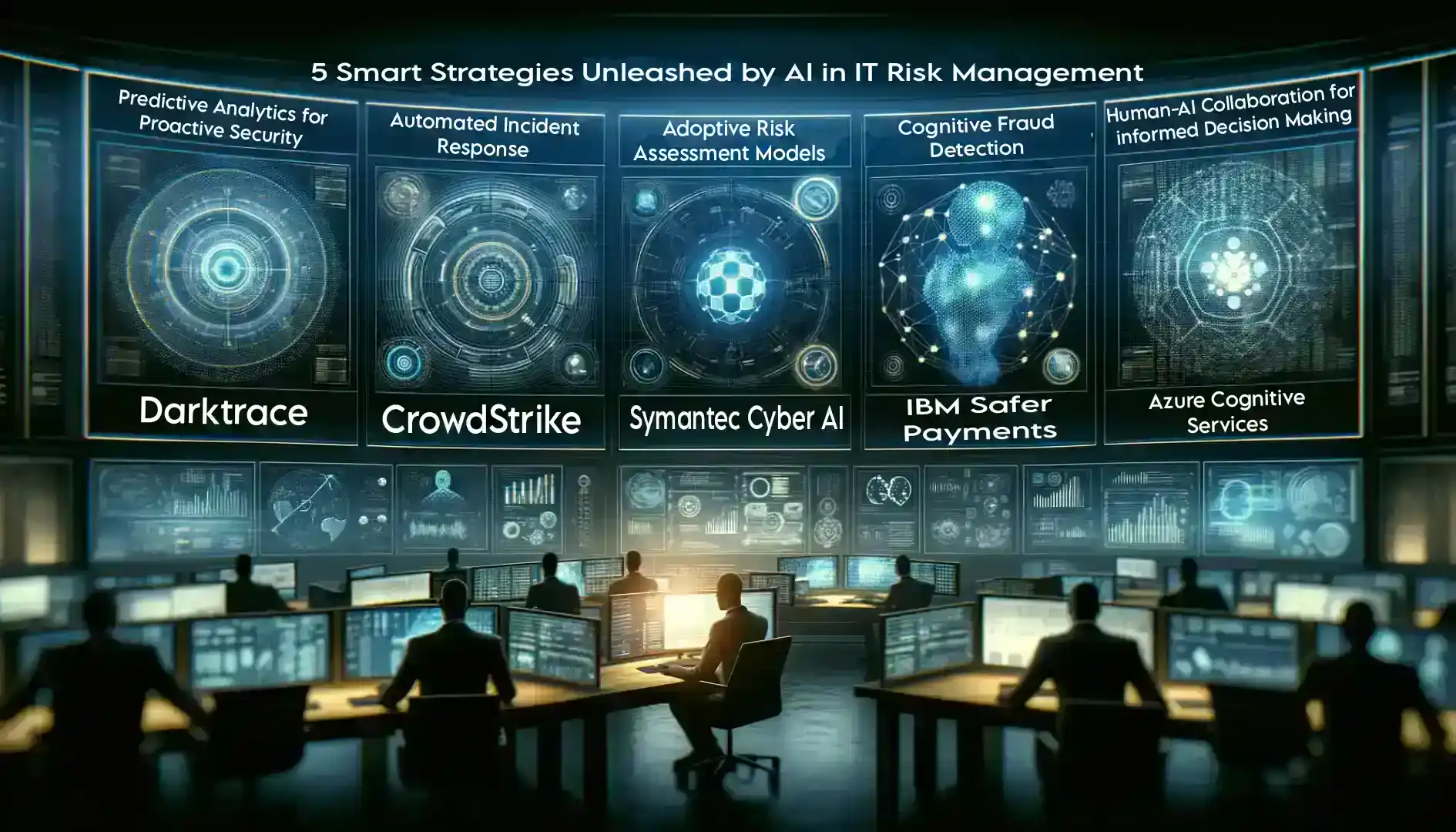Table of Contents
In the dynamic realm of AI in IT risk management, artificial intelligence (AI) stands out as a transformative catalyst, revolutionizing traditional approaches and fortifying organizational resilience against evolving threats. This exploration focuses on the pivotal role of AI in IT risk management, dissecting five strategic innovations poised to empower the IT future.

As the technological landscape evolves at an unprecedented pace, the integration of AI brings a paradigm shift, enabling organizations to proactively anticipate, analyze, and respond to risks with heightened efficiency and accuracy. The synergy between AI and risk management strategies presents a forward-looking perspective, where intelligent technology applications become instrumental in safeguarding digital assets and ensuring the longevity of IT infrastructures.
1. Predictive Analytics for Proactive Security
In the domain of AI in IT Risk Management, predictive analytics emerges as a pivotal strategy. Within the framework of AI in IT Risk Management, organizations harness the power of machine learning algorithms to conduct a comprehensive analysis of historical data. This AI-centric lens in IT Risk Management aims to identify patterns and forecast potential security threats with precision.
This proactive approach, integral to the ethos of AI in IT Risk Management, empowers organizations to take preemptive measures, thereby fortifying their security posture. By incorporating AI in IT Risk Management methodologies, vulnerabilities are proactively addressed before they can be exploited, showcasing the profound impact of predictive analytics as a cornerstone in safeguarding digital assets.
In the domain of AI in IT Risk Management, a widely adopted tool for Predictive Analytics for Proactive Security is “Darktrace.” Leveraging advanced machine learning algorithms, Darktrace meticulously sifts through historical data, identifying patterns, detecting anomalies, and predicting potential security threats in real time.
This proactive stance facilitated by AI empowers organizations to anticipate and address vulnerabilities before they can be exploited, reinforcing their cybersecurity posture. Darktrace’s integration within the broader framework of AI in IT Risk Management exemplifies the symbiotic relationship between cutting-edge technology and the imperative for preemptive security measures in today’s dynamic digital landscape.
2. Automated Incident Response
The significance of Automated Incident Response cannot be overstated. Confronted with the ever-growing specter of cyber threats, the expeditiousness of response emerges as a critical factor. AI-driven automated incident response systems play a pivotal role in this landscape, showcasing unparalleled proficiency in detecting and neutralizing threats in real time. To fully harness these benefits, organizations must also build an incident response team to oversee AI-driven processes, ensuring seamless integration and adaptability in handling complex cyberattacks. Through the infusion of AI in IT Risk Management, these systems not only bolster the organization’s defense mechanisms by reducing response times but also contribute to mitigating human errors that could potentially exacerbate vulnerabilities.
The integration of AI in IT Risk Management thus stands as a linchpin in fortifying the IT infrastructure against the fluid and evolving nature of emerging risks in the digital landscape. CrowdStrike Falcon emerges as a noteworthy tool for Automated Incident Response. Leveraging advanced artificial intelligence and machine learning capabilities, CrowdStrike Falcon plays a pivotal role in delivering robust endpoint security and comprehensive threat intelligence.
This AI-powered solution excels in providing automated responses to incidents, empowering organizations to respond swiftly and effectively to counteract emerging cyber threats. With its adaptive algorithms and real-time analysis, CrowdStrike Falcon stands as a testament to the transformative impact of AI in fortifying organizations against the evolving landscape of cybersecurity challenges.
3. Cognitive Fraud Detection
In the realm of AI in IT Risk Management, the significance of cognitive fraud detection cannot be overstated. Fraudulent activities frequently cloak themselves within the expansive realm of digital transactions, posing a persistent threat to organizational security. Here, AI in IT Risk Management introduces a cognitive edge to the process of fraud detection, leveraging advanced algorithms to discern subtle anomalies and patterns that are indicative of fraudulent behavior.
This sophisticated approach not only safeguards financial assets but also contributes significantly to enhancing the overall integrity of digital ecosystems. By seamlessly integrating AI into IT Risk Management protocols, organizations fortify their defenses against the ever-evolving landscape of cyber threats, ensuring a more resilient and secure foundation for their digital operations. In the realm of AI in IT Risk Management, a notable tool for Cognitive Fraud Detection is “IBM Safer Payments.”

This sophisticated solution leverages artificial intelligence to meticulously analyze transactional patterns, utilizing advanced algorithms to identify anomalies that could potentially indicate fraudulent activities. By integrating AI into the detection process, IBM Safer Payments significantly enhances the precision and efficiency of fraud detection, contributing to a formidable defense against deceptive practices within digital transactions. This exemplifies the transformative impact of AI in IT Risk Management, where intelligent tools like IBM Safer Payments play a crucial role in fortifying the security posture of organizations against evolving cyber threats.
4. Adaptive Risk Assessment Models
In the domain of AI in IT Risk Management, the significance of Adaptive Risk Assessment Models becomes pronounced. Traditional risk assessment models, inherently static, may encounter challenges in keeping pace with the dynamic threat landscape. The infusion of AI introduces a transformative level of adaptability, as these models continuously learn from new data, constantly refining and adjusting risk assessments in real time.
This adaptive capability becomes a linchpin in ensuring that risk management strategies not only stay relevant but also proactively respond to the fluid and ever-changing nature of cyber threats, a crucial aspect in fortifying the resilience of organizational cybersecurity frameworks. In the realm of AI in IT Risk Management, an exemplary tool for Adaptive Risk Assessment Models is Symantec Cyber AI.” This innovative solution harnesses the power of artificial intelligence and machine learning to seamlessly navigate the dynamic cybersecurity landscape.
Symantec Cyber AI, through its continuous learning capabilities, consistently evaluates and adapts to evolving data and patterns. This adaptive approach allows organizations to stay ahead of the curve, as the tool dynamically adjusts risk assessments in real time. By leveraging the intelligence provided by Symantec Cyber AI, businesses can confidently respond to emerging cyber threats and vulnerabilities, enhancing their overall resilience in the face of an ever-changing digital environment.
5. Human-AI Collaboration for Informed Decision-Making
The concept of human-AI collaboration for informed decision-making takes center stage. In this symbiotic relationship, the automation capabilities of AI enhance efficiency, yet the irreplaceable value of human intuition persists. The integration of AI tools into decision-making processes results in a dynamic partnership where AI offers data-driven insights. These insights, in turn, empower human decision-makers to navigate the complex landscape of IT risks, ensuring choices that not only align with organizational goals but also adhere to predefined risk tolerance thresholds.
This collaborative approach harnesses the strengths of both AI and human expertise, forging a resilient decision-making framework that is crucial for effective risk management in the ever-evolving digital landscape. In the realm of AI in IT Risk Management, Microsoft Azure Cognitive Services emerges as a powerful tool for facilitating human collaboration in decision-making. Within this suite of AI services, encompassing language understanding, speech recognition, and computer vision, Azure Cognitive Services stands as a cornerstone.
In decision-making scenarios about risk management, these AI capabilities play a pivotal role in analyzing and interpreting unstructured data, offering nuanced and valuable insights to inform human decision-makers. Through the seamless integration of Azure Cognitive Services, organizations can establish a symbiotic relationship, leveraging the strengths of both AI and human intelligence. This collaborative approach optimizes decision processes across diverse business contexts, enhancing the overall effectiveness of risk management strategies.
Concluding the Revolution of AI in IT Risk Management
The infusion of AI into IT risk management represents a pivotal shift, marking a paradigmatic change in how organizations confront and navigate the complexities of cybersecurity challenges. These transformative changes are embodied in the five smart strategies explicitly tailored for AI in IT risk management—predictive analytics, automated incident response, cognitive fraud detection, adaptive risk assessment models, and human-AI collaboration.

Together, they signal a future where IT landscapes are fortified, demonstrating adaptability and resilience in the face of evolving threats. As businesses actively adopt and integrate these AI-driven strategies into their risk management frameworks, they position themselves not merely as responders to present challenges but as proactive architects of their future security.
The amalgamation of human expertise with the capabilities of AI fosters a formidable defense mechanism against the intricate and dynamic threats prevalent in the digital age. The collective impact of these strategies is felt not only in the present cybersecurity landscape but also in the strategic preparedness to anticipate and mitigate risks that may emerge on the technological horizon. In the journey toward an empowered IT future, organizations are called to recognize AI in IT risk management as an indispensable strategic ally.
By embracing AI technologies, organizations not only shield their digital assets from immediate threats but also lay the foundation for a secure and resilient technological landscape. Undoubtedly, the trajectory of IT risk management is intricately tied to the intelligent integration of AI, carving new frontiers, and setting new standards in the perpetual pursuit of cybersecurity excellence.